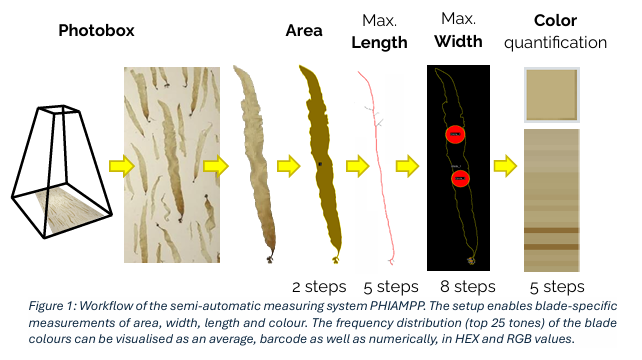OPTIMISING THE MEASUREMENT WORKFLOW OF GROWTH PARAMETERS FOR AN UPSCALING MACROALGAE INDUSTRY, INTRODUCING PHIAMPP: A POST-HARVEST HIGH-THROUGHPUT IMAGEJ-BASED ANALYSIS WORKFLOW FOR MACROALGAE PHENOTYPING, UTILISING A PHOTOBOX
Introduction:
Over the past thirty years, the macroalgae industry has developed into the fastest-growing aquaculture production, with an annual biomass output of over 35 million tons of fresh weight. However, similar to agriculture, both quantity and quality yields vary significantly between harvests due to various abiotic and biotic factors (Sugumaran et al., 2022, …). Monitoring the status of the crops and distinguishing between potential causes requires highly frequent and precise monitoring of individual macroalgae blade performances. However, while production and cultivation techniques have evolved into large-scale production, growth assessment methodologies have not advanced at the same rate. Furthermore, analysing a statistically meaningful sample size results in substantial working hours, which is amplified if multiple systems and different strains demand monitoring over multiple time points. Moreover, for other potentially vital parameters, e.g., colour, no standardised methodology exists. This creates an informational bottleneck. The automatic measurement of growth parameters, known as plant phenotyping, is a well established field in botany and agriculture. Its importance for the scaling of macroalgae production lines in microscopic and macroscopic stages has been well identified (Overrein et al., 2024, Dishon et al., 2024). First attempts to transfer established imaging technologies to aquatic plants have been conducted for area estimations, percentage calculations, the status of cultures (Overrein et al., 2024) or heat-induced stress on blades (Gonzales et al., 2025, …). While these approaches utilise parts of the image analysis toolkit, there is, to our knowledge, no comprehensive, user-friendly and efficient workflow published for the commonly used ImageJ/Fiji platform, which automatically measures even fundamental growth parameters of individual macroalgae blades and therefore strains. Here, we describe a methodology for both hardware and software, which establishes a semi-automatic analysis for post-harvest samples, utilising in-house developed ImageJ/Fiji, Excel/VBA scripts and standardised light settings. Altogether, these compounds combine existing functionalities in a novel manner to accurately measure relevant growth parameters such as colour, blade area, maximum width and length, per macroalgae blade, for hundreds of macroalgae in one image, while cutting working hours in half.
Methodology:
Manual workflow: … After the harvest of at least 100 individual blades of macroalgae, per length of cultivation substrate, the algae are cooled if not processed immediately. For the picture taking, the algae blades are placed manually onto a white background underneath the custom-built photo box. Length and/or colour scales, as well as metadata, are included. Digital workflow: … custom-written scripts for ImageJ/Fiji and Excel/VBA have been in-house developed to automate almost all necessary steps to measure and visualise the parameters of interest (blade area, maximum length, maximum width and RGB colour), with minimal observer interaction. …
Discussion:
While subtle variations in area, length and width were observed, no significant differences between the distribution of the manual and digital datasets were found, indicating a similar precision between the two approaches. This approach enables unprecedented measurements of currently unutilized parameters, such as the quantification and
processing of blade colour under standardised light regimes. The workflow has been applied to parts of the Saccharina ssp. harvest of the aquaculture research project ULTFARMS, which results in the establishment of a common image database between geographically distant production sites. This increase in standardised image-based data
sets will enable further development of advanced algorithms to expand the automated measurement of other relevant, more complex parameters, such as rhizoid width, sorus quantification. Within the near future, we envision a technological advancement in marine plant phenotyping, with similar success as it has been shown for land plants. Further methodological progress will undoubtedly benefit various fields of research in phycology, as it allows for insight into growth patterns relevant for plant health monitoring, pest management and strain performance.
References:
Sugumaran, R., Padam, B. S., Lym Yong, W. T., Saallah, S., Ahmed, K., & Yusof, N. A. (2022). A Retrospective Review of Global Commercial Seaweed Production—Current Challenges, Biosecurity and Mitigation Measures and Prospects. International Journal of Environmental Research and Public Health, 19(12), 7087. https://doi.org/10.3390/ijerph19127087
Dishon, G., Resetarits, H. M., Tsai, B., Black, K., Grossmann, J., & Smith, J. E. (2022). Image-based analysis and quantification of biofouling in cultures of the red alga Asparagopsis taxiformis. Journal of Applied Phycology, 35(1), 209–218. https://doi.org/10.1007/s10811-022-02884-y
Gonzalez, S. T., Bell, T. W., Aydlett, M., Bailey, D., Jones, A., Kerr, H., & Lindell, S. (2025). Predicting heat tolerance in sugar kelp juvenile sporophytes via gametophyte heat stress testing. Journal of Applied Phycology. https://doi.org/10.1007/s10811-025-03454-8
Overrein MM, Tinn P, Aldridge D, Johnsen G and Fragoso GM (2024) Biomass estimations of cultivated kelp using underwater RGB images from a mini-ROV and computer vision approaches. Front. Mar. Sci. 11:1324075. https://doi.org/10.3389/fmars.2024.1324075
